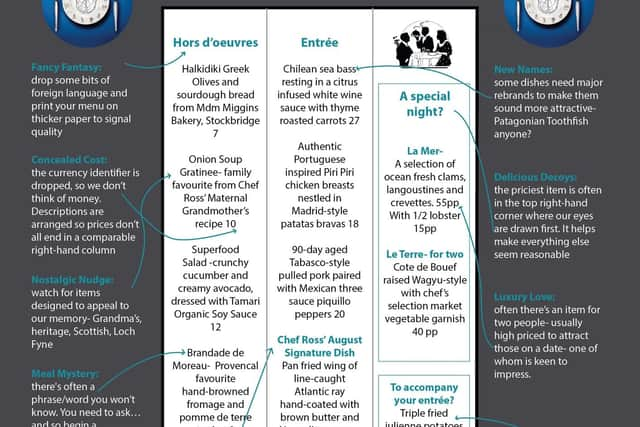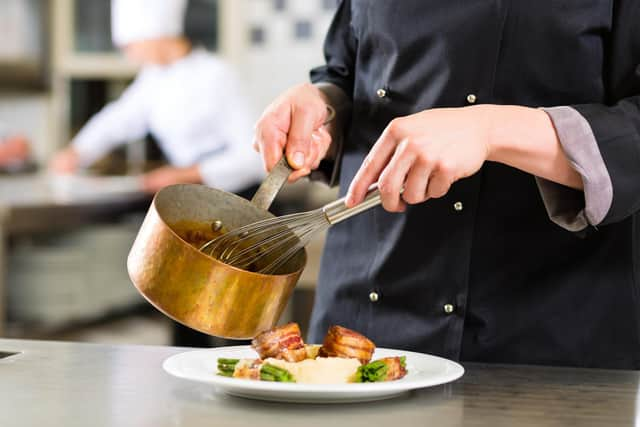Is menu manipulation costing you money?
The cost of living crisis continues to bite but we're still celebrating birthdays and anniversaries and it’s always a treat to book a table at a favourite restaurant and enjoy the warm personal welcome from the staff.
But is there a dark side to your local eatery? What does your credit card tell you? Are they using techniques to persuade you to pay for overpriced dishes you don’t really want, and drink more expensive wine than your liver can afford? I’m afraid the answer is, yes. As part of my work in behavioural science, I study how eateries – from Michelin-starred restaurants to neighbourhood cafes – use psychological techniques to upsell and sometimes oversell to diners like you and me. Let me share some of those secrets – and save you some money.
Advertisement
Hide AdAdvertisement
Hide AdThe process starts with a technique known as priming – exploiting the power of positive reviews on social media. They encourage friends, staff and influencers to upload glowing reviews. They especially ask reviewers to mention how caring or thoughtful the servers were, since our initial choice is mostly based on the desire to have a good time. An investigation by the Times in September 2018 found almost 33 per cent of Trip Advisor reviews were fake. Trip Advisor itself took down 1.3M dodgy reviews last year.


Why do restaurants fake reviews? Our evolutionary past hardwires us to be herd animals – to pay attention what others do and then copy it. So, when we see a restaurant with lots of positive endorsements, we’re more inclined to visit. This herding works “live” too. In a new city in a street filled with restaurants, faced with a choice of an empty eatery or one with a queue, how many of us will join the queue, rather than walk in somewhere we can get a table straightaway?
Let’s assume you’ve chosen your restaurant. As soon as you walk in you should get the vibe or ambience. One key part of that is music – music that you probably barely notice, if at all. Western Kentucky University have established that even unnoticed slow music played in background increases a restaurant’s profits by 38 per cent compared to no-music.
You sit down and are handed a menu, or menus. There are usually at least three: one for wine, one for starters and mains, and one for desserts. The reason? To stop you adding up in your head the overall cost. Our mental accounting means we tend to have defined budgets in our head. Three menus make it hard to keep a tally of the total spend.
While we’re on cost, have you noticed that in most restaurants – from pizza places to fancier three-star establishments – the £/€/$ sign has disappeared? According to Phil Barden in his terrific book on salespsychology Decoded, removing the money signifier makes us think less about cost. His research says this simple omission leads to an average of £5 more spent between a party of four.


Let’s spend a little more time considering the actual menu itself. In “posher” restaurants it’s printed on heavier paper. And it’s perhaps presented in a nice faux leather folder... Research says that the weight subconsciously whispers “quality” and we don’t mind paying more for quality. In a fine restaurant the cutlery itself is often heavier than at home. In his book Gastrophysics, Charles Spence, Professor of Experimental Psychology at Oxford University, shows food eaten with heavier cutlery with be rated as tastier and people will pay up to 15 per cent more. (In contrast a fast-food outlet often uses vinyl and pictures to suggest they’re value for money.)
The menu itself is a work of psychological sophistry. Language is key here. Russell Norman ran Polpo, the fancy Venetian – not merely Italian – restaurant in London. His menudescriptions were lightly “garnished” with unfamiliar Italian words. In an interview he said: “I occasionally use [unfamiliar Italian words] so that customers have to ask the server, ‘What is that?’ He maintains that by including an easy-to-pronounce but unfamiliar word like ‘suppli’ (sort of small arancini), he can start a conversation between diner and waiter. That conversation signals this is not just an ordinary Italian restaurant – and gives the waiter a chance to upsell.
Sometimes language changes the whole way we perceive something. When was the last time you enjoyed the very ugly Patagonian Toothfish. “Never,” you say? Well, I bet you have. In the 1970s Lee Lantz, a US seafood merchant, was looking for new species to market. While on a trip to Chile, he tried Patagonian Toothfish, a fish he had never heard of. The first mouthful revealed a mild white fish with delicious “buttery” taste. And it lent itself to simple, quick grilling. Perfect! Lee had only two problems: the fish was very ugly and had an ugly name to match.
Advertisement
Hide AdAdvertisement
Hide AdIn a moment of marine marketing genus, he renamed the unhappy fish Chilean Sea Bass – today one of the most popular and profitable items on any menu.


Here are three other bill-inflating common ploys to watch out for: Decoy items – restaurants frequently have an expensive decoy item. This is not really for ordering but to make the other items seem reasonable.
Preparation time: One item often talks about preparation time – the labour illusion encourages us to pay more for dishes we think involve more work.
Box outs: On average we spend just 109 seconds scanning a menu before making an initial choice. Our eyes are drawn to anything on the page that’s different – like in a box.
Surely we’re safe drinking…? Well no. Usually whoever the server defines as the alpha person in the group is given the wine list (don’t get me started on sexism). What does the alpha do? Well unless he (yep) really knows his wine he’s most likely to choose… the second most expensive and reject what is probably the good and reasonably priced house wine.
And what about wine glasses? Restaurants are serving wine in bigger ones generally, and there’s a reason. If you put the standard 125ml measure into a 300ml glass it looks generous, and you drink it more slowly. Put the same amount in a 350ml glass – those big ones that scream "classy” – and it appears you’re getting less wine, which makes it “OK” to drink it more quickly. According to University of Bristol research, using a big glass will, on average, increase consumption and profits by 15 per cent.
And now you’ve finished the meal and asked for the bill. You’ll probably be asked to pay on an electronic terminal where you’ll also be prompted to tip. The screen will offer a range of between three and five options in percentages from 10 per cent up through 15 per cent and maybe even a whopping 20 per cent.
Whatever it is, most people choose the middle option, and fall victim to extremeness aversion. Like Goldilocks we like our choice to be not too hot or too cold, but just right. The middle option seems just right.
Advertisement
Hide AdAdvertisement
Hide AdReady to face the restaurant Patron’s psychological warfare? Maybe cut out my little graphic to share. Or use it as a behavioural bistro bingo card, ticking off as many of the techniques as you can.
Bernard Ross is a behavioural science consultant and author helping charities to tackle big social issues. You can find out about his work – and more about how predictably irrational you are at www.decisionscience.org.uk
Comments
Want to join the conversation? Please or to comment on this article.